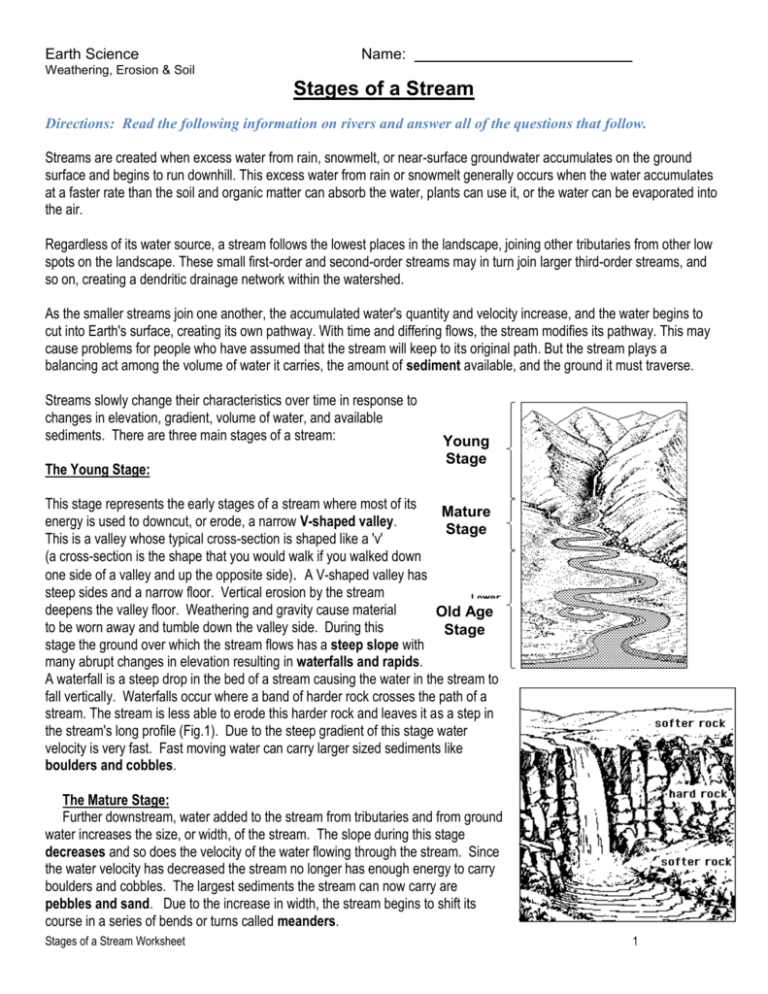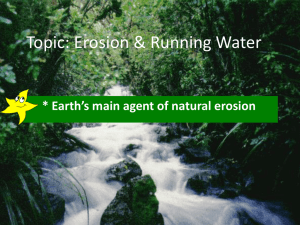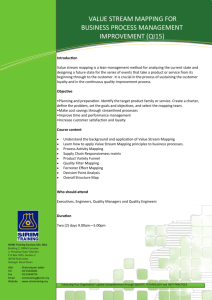Stages of a Stream: Weathering, Erosion & Soil Worksheet
advertisement

Earth Science Name: Weathering, Erosion & Soil Stages of a Stream Directions: Read the following information on rivers and answer all of the questions that follow. Streams are created when excess water from rain, snowmelt, or near-surface groundwater accumulates on the ground surface and begins to run downhill. This excess water from rain or snowmelt generally occurs when the water accumulates at a faster rate than the soil and organic matter can absorb the water, plants can use it, or the water can be evaporated into the air. Regardless of its water source, a stream follows the lowest places in the landscape, joining other tributaries from other low spots on the landscape. These small first-order and second-order streams may in turn join larger third-order streams, and so on, creating a dendritic drainage network within the watershed. As the smaller streams join one another, the accumulated water's quantity and velocity increase, and the water begins to cut into Earth's surface, creating its own pathway. With time and differing flows, the stream modifies its pathway. This may cause problems for people who have assumed that the stream will keep to its original path. But the stream plays a balancing act among the volume of water it carries, the amount of sediment available, and the ground it must traverse. Streams slowly change their characteristics over time in response to changes in elevation, gradient, volume of water, and available sediments. There are three main stages of a stream: The Young Stage: Young Stage This stage represents the early stages of a stream where most of its Mature energy is used to downcut, or erode, a narrow V-shaped valley. Stage This is a valley whose typical cross-section is shaped like a 'v' (a cross-section is the shape that you would walk if you walked down one side of a valley and up the opposite side). A V-shaped valley has steep sides and a narrow floor. Vertical erosion by the stream deepens the valley floor. Weathering and gravity cause material Old Age to be worn away and tumble down the valley side. During this Stage stage the ground over which the stream flows has a steep slope with many abrupt changes in elevation resulting in waterfalls and rapids. A waterfall is a steep drop in the bed of a stream causing the water in the stream to fall vertically. Waterfalls occur where a band of harder rock crosses the path of a stream. The stream is less able to erode this harder rock and leaves it as a step in the stream's long profile (Fig.1). Due to the steep gradient of this stage water velocity is very fast. Fast moving water can carry larger sized sediments like boulders and cobbles. The Mature Stage: Further downstream, water added to the stream from tributaries and from ground water increases the size, or width, of the stream. The slope during this stage decreases and so does the velocity of the water flowing through the stream. Since the water velocity has decreased the stream no longer has enough energy to carry boulders and cobbles. The largest sediments the stream can now carry are pebbles and sand. Due to the increase in width, the stream begins to shift its course in a series of bends or turns called meanders. Stages of a Stream Worksheet 1 As the water flows down a stream, its speed is faster on the outside of the meander causing erosion and slower on the inside of the meander resulting in deposition. This is how meanders are created (Fig. 2). During times of flooding, when the stream overflows its banks, it deposits, or releases, sediments. Each time this occurs a thin layer of fine material is laid down on both sides of the river forming a flood plain (Fig. 3). During this stage a very narrow flood plain forms. Figure 2: Formation of meanders. Stream erodes the outer bank of a meander, and deposits sediment on the inner bank. Figure 3: Flood plain- This is an area of flat land found on either side of a river. The Old Age Stage: A stream greatly slows down in its oldest stage and begins to cut, or erode, a very wide valley and an equally wide flood plain. Since the water velocity has further decreased from the previous stage it no longer has enough energy to carry pebbles and sand. Now it can only carry smaller sized sediments like silt. This stage also possesses meanders which curve even more than in the mature stage. Due to the larger size of these meanders ox-bow lakes are often seen. An oxbow lake is a horseshoe lake found on the flood plain of a stream (Fig.4). Meanders may form a loop so that only a narrow neck of land separates their outer banks. In a heavy flood the stream cuts through this neck leaving the loop as a cut-off. This cut-off section becomes an ox-bow lake. During this older stage the stream usually comes to an end when the flow enters a sea or lake. This is known as the mouth of the stream. Where a river meets the sea or a lake the ground is virtually flat so its speed slows down and it deposits, or releases, all of the sediments it was carrying. This leads to a fan-shaped deposit extending out to sea called a delta (Fig.5). Figure 4: Formation of an ox-bow lake. This is a truncated (cut off) section of a meander in the stream channel which forms a 'c' shape. Stages of a Stream Worksheet Figure 5: Delta. This is a fan- shaped area of sandy / muddy sediment built up into the open water where a stream meets the sea. 2 PART 1: WORD MEANINGS Highlight the words found in the reading and listed below and then use the passage to define the terms. 1. Dendritic 2. Traverse 3. Abrupt 4. Profile 5. Tributaries 6. Meander 7. Deposits 8. Flood Plain 9. Delta 10. Oxbow Lake Reading for Meaning Directions: Based on the reading, decide if you agree or disagree with the following statements. Be sure to quote the part of the reading that helped you form this opinion. Agree The mature stage represents the early stages of a stream where most of its energy is used to erode a narrow V-shaped valley. Support Stages of a Stream Worksheet Disagree Refute 3 Agree Disagree A steep gradient can be associated with fast velocity. Support Agree Refute The mouth of the stream is associated with the entry point to a sea, lake or ocean. Support Part 2: Disagree Refute Use your notes and the reading above answer the following questions on rivers. 1. Which of the following statements is true concerning a Youthful River: a. Area erosion is primarily caused by lateral, side-to-side, water movement. b. Area erosion is primarily caused by the river downcutting into the bedrock below. c. Erosional forces cause meander curves to develop in surrounding bedrock. d. Deposition is greater than erosion in Young Rivers. 2. Youthful Rivers carry their sediment load in the following manner: a. In solution only. b. As a suspended load. c. By rolling, bouncing, and suspension. d. All of the above. 3. Youthful Rivers are generally found: a. Where the river empties into a lake or ocean. b. On flat plains, with hilly landscapes located at great distances from the actual river. c. At higher elevations, often in mountainous areas, where slopes are steeper. d. Within broad, flat floodplains that are saturated with swamps and oxbow lakes. Stages of a Stream Worksheet 4 4. The following illustration shows 4 different river profiles. Which river profile best represents the cross-section of a Youthful River? 5. The steep escarpment shown in the illustration above may have been formed by: a. River erosion, only. b. A fault in the rock layers. c. Differential weathering and many years of erosion due to down-cutting by the river. d. An igneous intrusion with associated volcanic eruptions. The following diagram pertains to Questions 6 & 7 which shows 2 views of the same river flowing from a lake to an ocean bay. The top image is a cross-sectional view and the bottom one is an aerial view. 6. The deposition in Dolphin Bay near location D is caused mainly by a. Increased wave action in Dolphin Bay. b. Meanders in the river. c. The difference in the salt content between Clear Lake and Dolphin Bay. d. A decrease in the water velocity as it enters Dolphin Bay. 7. How do the size and the density of particles deposited in Dolphin Bay generally change as the distance from the shoreline increases? a. Both size and density decrease. b. Size increases and density decreases. c. Both size and density increase. d. Size decreases and density increases. Stages of a Stream Worksheet 5 The following illustration pertains to Questions 8 - 11. The diagrams show 3 different rivers, each with the same volume of water but each one in a different stage of river development. 8. Which River shows the most advanced stage of river development? (The oldest river) a. River 1 b. River 2 c. River 3 9. The oxbow lake in the River 3 view was formed because of: a. The weathering of granite bedrock. b. The erosion and deposition of sediments in the surrounding floodplain. c. An increased volume of water in the river. d. Uplift of the crust in the area. 10. What is true concerning the velocity of river water in Views 2 and 3? a. Water velocity is fastest on outside meander curves. b. Water velocity is fastest on inside meander curves. c. Water velocity is equal on both the outside and inside meander curves. 11. Which of the following is a significant difference between the 3 river views as one observes first River 1, then River 2 and finally River 3? a. The river channels become increasingly narrower. b. Water volume increases. c. An ever-widening floodplain forms. d. The amount of vegetation in the area decreases. Stages of a Stream Worksheet 6








